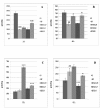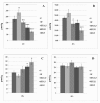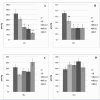Effect of dietary krill oil supplementation on the endocannabinoidome of metabolically relevant tissues from high-fat-fed mice
- PMID: 21749725
- PMCID: PMC3154144
- DOI: 10.1186/1743-7075-8-51
Effect of dietary krill oil supplementation on the endocannabinoidome of metabolically relevant tissues from high-fat-fed mice
Abstract
Background: Omega-3 polyunsaturated fatty acids (ω-3-PUFA) are known to ameliorate several metabolic risk factors for cardiovascular disease, and an association between elevated peripheral levels of endogenous ligands of cannabinoid receptors (endocannabinoids) and the metabolic syndrome has been reported. We investigated the dose-dependent effects of dietary ω-3-PUFA supplementation, given as krill oil (KO), on metabolic parameters in high fat diet (HFD)-fed mice and, in parallel, on the levels, in inguinal and epididymal adipose tissue (AT), liver, gastrocnemius muscle, kidneys and heart, of: 1) the endocannabinoids, anandamide and 2-arachidonoylglycerol (2-AG), 2) two anandamide congeners which activate PPARα but not cannabinoid receptors, N-oleoylethanolamine and N-palmitoylethanolamine, and 3) the direct biosynthetic precursors of these compounds.
Methods: Lipids were identified and quantified using liquid chromatography coupled to atmospheric pressure chemical ionization single quadrupole mass spectrometry (LC-APCI-MS) or high resolution ion trap-time of flight mass spectrometry (LC-IT-ToF-MS).
Results: Eight-week HFD increased endocannabinoid levels in all tissues except the liver and epididymal AT, and KO reduced anandamide and/or 2-AG levels in all tissues but not in the liver, usually in a dose-dependent manner. Levels of endocannabinoid precursors were also generally down-regulated, indicating that KO affects levels of endocannabinoids in part by reducing the availability of their biosynthetic precursors. Usually smaller effects were found of KO on OEA and PEA levels.
Conclusions: Our data suggest that KO may promote therapeutic benefit by reducing endocannabinoid precursor availability and hence endocannabinoid biosynthesis.
Figures







References
-
- Devane WA, Dysarz FA, Johnson MR, Melvin LS, Howlett AC. Determination and characterization of a cannabinoid receptor in rat brain. Mol Pharmacol. 1988;34:605–613. - PubMed
LinkOut - more resources
Full Text Sources
Other Literature Sources
Research Materials

